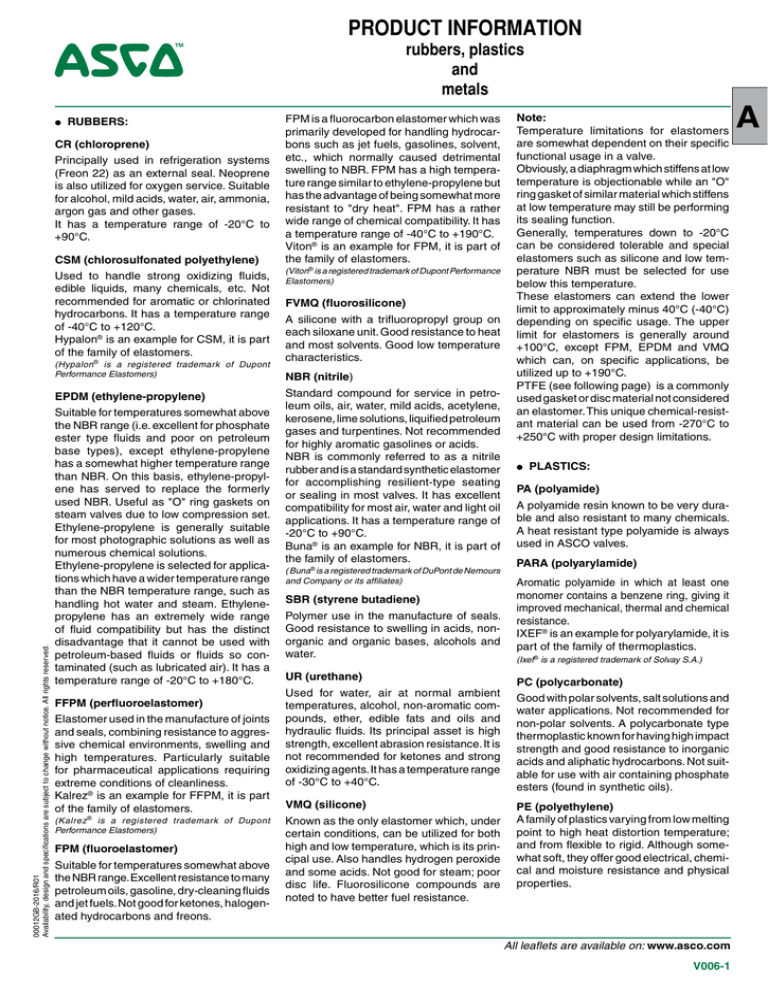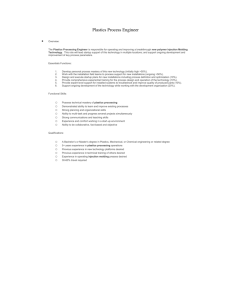
PRODUCT INFORMATION
rubbers, plastics
and
metals
●
RUBBERS:
CR (chloroprene)
Principally used in refrigeration systems
(Freon 22) as an external seal. Neoprene
is also utilized for oxygen service. Suitable
for alcohol, mild acids, water, air, ammonia,
argon gas and other gases.
It has a temperature range of -20°C to
+90°C.
CSM (chlorosulfonated polyethylene)
Used to handle strong oxidizing fluids,
edible liquids, many chemicals, etc. Not
recommended for aromatic or chlorinated
hydrocarbons. It has a temperature range
of -40°C to +120°C.
Hypalon® is an example for CSM, it is part
of the family of elastomers.
(Hypalon ® is a registered trademark of Dupont
Performance Elastomers)
00012GB-2016/R01
Availability, design and specifications are subject to change without notice. All rights reserved.
EPDM (ethylene-propylene)
Suitable for temperatures somewhat above
the NBR range (i.e. excellent for phosphate
ester type fluids and poor on petroleum
base types), except ethylene-propylene
has a somewhat higher temperature range
than NBR. On this basis, ethylene-propylene has served to replace the formerly
used NBR. Useful as "O" ring gaskets on
steam valves due to low compression set.
Ethylene-propylene is generally suitable
for most photographic solutions as well as
numerous chemical solutions.
Ethylene-propylene is selected for applications which have a wider temperature range
than the NBR temperature range, such as
handling hot water and steam. Ethylenepropylene has an extremely wide range
of fluid compatibility but has the distinct
disadvantage that it cannot be used with
petroleum-based fluids or fluids so contaminated (such as lubricated air). It has a
temperature range of -20°C to +180°C.
FFPM (perfluoroelastomer)
Elastomer used in the manufacture of joints
and seals, combining resistance to aggressive chemical environments, swelling and
high temperatures. Particularly suitable
for pharmaceutical applications requiring
extreme conditions of cleanliness.
Kalrez® is an example for FFPM, it is part
of the family of elastomers.
(Kalrez ® is a registered trademark of Dupont
Performance Elastomers)
FPM (fluoroelastomer)
Suitable for temperatures somewhat above
the NBR range. Excellent resistance to many
petroleum oils, gasoline, dry-cleaning fluids
and jet fuels. Not good for ketones, halogenated hydrocarbons and freons.
FPM is a fluorocarbon elastomer which was
primarily developed for handling hydrocarbons such as jet fuels, gasolines, solvent,
etc., which normally caused detrimental
swelling to NBR. FPM has a high temperature range similar to ethylene-propylene but
has the advantage of being somewhat more
resistant to "dry heat". FPM has a rather
wide range of chemical compatibility. It has
a temperature range of -40°C to +190°C.
Viton® is an example for FPM, it is part of
the family of elastomers.
(Viton® is a registered trademark of Dupont Performance
Elastomers)
FVMQ (fluorosilicone)
A silicone with a trifluoropropyl group on
each siloxane unit. Good resistance to heat
and most solvents. Good low temperature
characteristics.
NBR (nitrile)
Standard compound for service in petroleum oils, air, water, mild acids, acetylene,
kerosene, lime solutions, liquified petroleum
gases and turpentines. Not recommended
for highly aromatic gasolines or acids.
NBR is commonly referred to as a nitrile
rubber and is a standard synthetic elastomer
for accomplishing resilient-type seating
or sealing in most valves. It has excellent
compatibility for most air, water and light oil
applications. It has a temperature range of
-20°C to +90°C.
Buna® is an example for NBR, it is part of
the family of elastomers.
( Buna® is a registered trademark of DuPont de Nemours
and Company or its affiliates)
SBR (styrene butadiene)
Polymer use in the manufacture of seals.
Good resistance to swelling in acids, nonorganic and organic bases, alcohols and
water.
UR (urethane)
Note:
Temperature limitations for elastomers
are somewhat dependent on their specific
functional usage in a valve.
Obviously, a diaphragm which stiffens at low
temperature is objectionable while an "O"
ring gasket of similar material which stiffens
at low temperature may still be performing
its sealing function.
Generally, temperatures down to -20°C
can be considered tolerable and special
elastomers such as silicone and low temperature NBR must be selected for use
below this temperature.
These elastomers can extend the lower
limit to approximately minus 40°C (-40°C)
depending on specific usage. The upper
limit for elastomers is generally around
+100°C, except FPM, EPDM and VMQ
which can, on specific applications, be
utilized up to +190°C.
PTFE (see following page) is a commonly
used gasket or disc material not considered
an elastomer. This unique chemical-resistant material can be used from -270°C to
+250°C with proper design limitations.
●
PLASTICS:
PA (polyamide)
A polyamide resin known to be very durable and also resistant to many chemicals.
A heat resistant type polyamide is always
used in ASCO valves.
PARA (polyarylamide)
Aromatic polyamide in which at least one
monomer contains a benzene ring, giving it
improved mechanical, thermal and chemical
resistance.
IXEF® is an example for polyarylamide, it is
part of the family of thermoplastics.
(Ixef® is a registered trademark of Solvay S.A.)
PC (polycarbonate)
Used for water, air at normal ambient
temperatures, alcohol, non-aromatic compounds, ether, edible fats and oils and
hydraulic fluids. Its principal asset is high
strength, excellent abrasion resistance. It is
not recommended for ketones and strong
oxidizing agents. It has a temperature range
of -30°C to +40°C.
Good with polar solvents, salt solutions and
water applications. Not recommended for
non-polar solvents. A polycarbonate type
thermoplastic known for having high impact
strength and good resistance to inorganic
acids and aliphatic hydrocarbons. Not suitable for use with air containing phosphate
esters (found in synthetic oils).
VMQ (silicone)
PE (polyethylene)
A family of plastics varying from low melting
point to high heat distortion temperature;
and from flexible to rigid. Although somewhat soft, they offer good electrical, chemical and moisture resistance and physical
properties.
Known as the only elastomer which, under
certain conditions, can be utilized for both
high and low temperature, which is its principal use. Also handles hydrogen peroxide
and some acids. Not good for steam; poor
disc life. Fluorosilicone compounds are
noted to have better fuel resistance.
All leaflets are available on: www.asco.com
V006-1
A
Plastics and metals - PRODUCT INFORMATION
PTFE Reinforced
High performance thermoplastic with
exceptional resistance to a wide range of
chemical environments including at high
temperatures.
PTFE reinforced is a form of PTFE having
fillers which have been added for improved
mechanical properties. PTFE and TPFE with
fillers are considered more of a plastic than
a resilient-type material. They are virtually
unattacked by any fluid. Their temperature
usage ranges from discs for cryogenic
valves to discs for steam valves. The "cold
flow" characteristics may contribute to
leakage particularly on gases. They have a
temperature range of -270°C to +250°C.
Rulon® is an example for reinforced PTFE,
it is part of the family of plastics.
PEI (polyetherimide)
This resin has good heat deflection
characteristics. Good chemical resistance to non-oxidizing acids and polar
solvents. Questionable usage on alkaline solutions. Ultem® is an example for
PEI, it is part of the family of plastics.
(Ultem® is a registered trademark of General Electric
Company)
POM (polyacetal or polyoxymethylene)
Acetal resin type thermoplastics are extremely rigid but not brittle. They provide
good toughness, tensile strength, stiffness
and long life. They are odourless, tasteless,
non-toxic and resistant to most solvents.
Delrin® is an example for polyacetal, it is part
of the family of plastics.
(Delrin® is a registered trademark of DuPont de Nemours
and Company or its affiliates)
PP (polypropylene)
A thermoplastic known to have excellent
resistance to inorganic salts, mineral acids and gases. It offers good resistance to
photographic solutions and is one of the
few plastics that has the ability to withstand
steam sterilization.
PPS (polyphenylene sulfide)
This resin has outstanding chemical resistance and no known solvents below 200°C. It
has low friction, good wear resistance and
high tensile strength.
Ryton® is an example for PPS, it is part of
the family of plastics.
(Ryton® is a registered trademark of Chevron Philips
Chemical Company)
PSU (polysulfone)
Known as one of the most heat resistant of
the thermoplastics. It has excellent chemical
resistance when used for inorganic acids,
alkalies and aliphatic hydrocarbons.
PTFE (polytetrafluoroethylene)
A fluorcarbon resin known to be suitable
for disc material where all other synthetic
materials have failed. Teflon® is not easily
fabricated and is known to have objectionable "cold flow" characteristics.
Teflon® is an example for PTFE, it is part of
the family of plastics.
(Teflon® is a registered trademark of DuPont de Nemours
and Company or its affiliates)
All leaflets are available on: www.asco.com
V006-2
(Rulon® is a registered trademark of Saint Gobain
Performance Plastics Corporation)
PUR (polyurethane)
●
METALS:
Ag (silver)
Shading coil material for stainless steel
valves.
Al (aluminum)
Shading coil material for special fluids or for
making washers, etc. Die cast aluminum is
generally used for bodies for low pressure
gas valves and can only be used with "water
free" systems. It can be noted that die cast
aluminum is successfully used in oil and
gasoline applications.
Cu (copper)
Primarily used for shading coil.
CU Sn (bronze)
Polyurethane is a multipurpose, robust
product. It has good adhesion to a variety of
substrates, providing resistance to humidity
and impact strength.
Casting bronze is used for body forging.
Good sealing and casting properties, resistant to abrasion.
PVC (polyvinyl chloride)
Cu Zn Pb (brass)
Known for its chemical inertness but has
somewhat less temperature resistance
than most other plastics. PVC has excellent resistance to strong alkalies, mineral
acids, salts and many chemicals corrosive
to conventional materials.
Forging brass is used in our body forgings.
Forging brass has a composition of 59%
copper, 2% lead and 39% zinc.
PVDF (polyvinylidene fluoride)
Polymer resistant to atmospheric agents
and the majority of chemical products at
ambient temperature. High purity PVDF
compounds are particularly recommended
for medical applications.
TPE (thermoplastic polyester elastomer)
Fe Cr Ni (stainless steel AISI 303 or 304)
One of the most widely used steels containing 18% chromium and 8% nickel. Used for
valve bodies, springs and internal parts.
Known as stainless steel type 303 or 304.
Fe Cr Ni Mo (stainless steel AISI 316)
Alloy containing approx 17 % chromium,
12% nickel and 2 % molybdenum. Highly
corrosion resistant.
Used in some diaphragm applications. HYT
elastomers show high strength in tension,
compression and flex. They are superior
to polyurethane rubbers in load-bearing
capacity.
Hytrel® (HYT) is an example for a polyester elastomer, it is part of the family of
plastics.
Fe Cr Ni Mo (stainless AISI 316L)
(Hytrel® is a registered trademark of DuPont)
Core material for low temperature fluids
(below -100°C) particularly for "long stroke"
solenoids.
Alloy containing 16 to 18% chromium, 11 to
14% nickel and 2,5 to 3% molybdenum.
Valve bodies made from this material
provide excellent resistance to particularly
aggressive fluids.
Ni Fe (nickel iron)
Pb (lead)
Gaskets - sometimes - lead-clad copper
gaskets.
Zamak
Zinc alloy containing approx. 4% aluminium,
0,04% magnesium and 1% copper. Used,
for example, for the bodies of air treatment
equipment .
00012GB-2016/R01
Availability, design and specifications are subject to change without notice. All rights reserved.
PEEK (polyetheretherketone)





